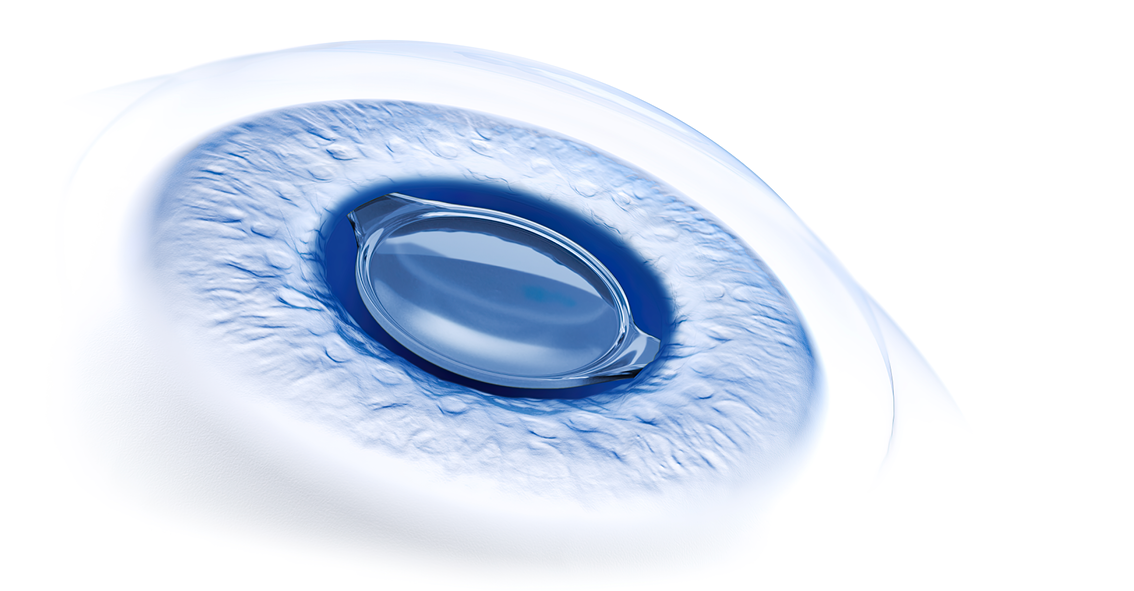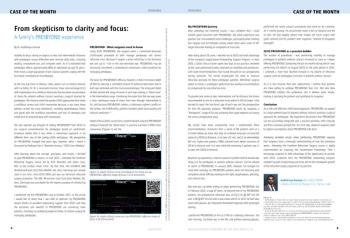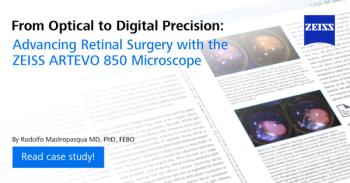
The ZEISS IOL Power Calculation Service. Providing guidance in complex cases

Advances in biometric technology and IOL calculation formulas have enabled refractive accuracy of cataract and clear lens exchange (CLE) surgery, but IOL power selection remains challenging in some cases. I have found that the ZEISS IOL Power Calculation Service (IPCS) is a valuable asset to help me in these uncertain situations.
Advances in biometric technology and IOL calculation formulas have enabled refractive accuracy of cataract and clear lens exchange (CLE) surgery, but IOL power selection remains challenging in some cases. I have found that the ZEISS IOL Power Calculation Service (IPCS) is a valuable asset to help me in these uncertain situations.
As described below, guidance from the ZEISS IPCS in one such case allowed me to proceed confidently with my IOL decision. Happily, I can report that the patient achieved a good refractive outcome and his desire for becoming spectacle-independent postoperatively.
Case history
The patient was a 51-year-old male with presbyopia and high hyperopic astigmatism (manifest refraction OD: +8.00 -3.50 @25° OS: +7.50 -3.50 @155°). He had worn contact lenses for a long time but was feeling discomfort due to dry eye and occupational dust exposure. Now he was interested in surgery that would free him from wearing glasses, and my impression was that he was going to be a rather demanding patient with high expectations.
The patient was educated about his surgical options and chose CLE with implantation of the AT LISA® tri toric 949MP IOL from ZEISS. The AT LISA tri toric 949MP is my preferred IOL when patients need astigmatic correction and want spectacle independence because it is time-tested to deliver excellent visual quality and rotational stability. I planned to operate on the nondominant eye (OD) first and decide on the IOL for the second eye based on the patient’s postoperative satisfaction.
The patient underwent a comprehensive evaluation that showed he was a good candidate for a trifocal IOL. Biometry values obtained with the IOLMaster® 700 from ZEISS made me think I would face challenges with IOL power calculations. In addition to short eyes (axial length 22.19/21.83 mm OD/OS), OS to OD differences in anterior chamber depth (2.72 vs 3.32 mm) and lens thickness (4.60 vs 4.22 mm) as well as flat keratometry values in both eyes indicated a possible need for a higher IOL power than predicted. I used the online IOL calculator Z CALC® from ZEISS and the Barett TK toric formula on the IOLMaster, but their results were far from agreeing (Figure 1). I had learned
about the ZEISS IPCS from a sales representative several years earlier, found this free of charge service helpful, and turned to it again in this situation.
ZEISS IOL Power Calculation Service
ZEISS introduced the ZEISS IPCS in 2005, and in recent years surgeons have sought out this resource to perform more than 20,000 calculations annually. The power calculations are done for ZEISS IOLs using a proprietary patented algorithm that incorporates design specifications for each IOL model in addition to biometry. The service can support IOL power selection for any eye, including extreme cases involving irregular/highly aberrated pre-operated corneas and those with biometric values outside normal limits. I believe surgeons might also find it useful for obtaining a second opinion of the postoperative target results predicted by their own IOL power calculations.
Surgeons submit their request to the ZEISS IPCS via email (
Case continued
I decided to follow ZEISS IPCS proposal (Figure 2) and to take the mean value between both cylinder prediction values (OD cyl. 4.0D) as it seemed to carry the smallest risk by coming between accepting the minimal overcorrection in cylinder according to Barett TK toric or the slight undercorrection according to Z CALC. The corresponding IOL SE was selected based on the cylinder value. I also prefer a slight myopic result that I find is better tolerated in my patients. I placed an order for an AT LISA tri toric 949MP SE +29.5 D CYL +4.0D.
I used the ZEISS CALLISTO eye® markerless system for guiding the toric IOL alignment, and the procedure was completed uneventfully. On postop day 1, the subjective refraction was SE -0.5 (sph. -0.50) and visual acuity 1.0 (decimal) uncorrected at distance and Parinaud P1.4 (Jaeger equivalent ~J1) at 30 cm for reading. I asked the patient to return 4 days later for another follow-up and he greeted me with a smile requesting the same IOL in his fellow eye.
For the dominant eye I ordered an AT LISA tri toric 949MP SE +31.0 D CYL +3.5 D, which was the option that would result in slight myopia (~ -0.50 D) if the worst-case scenario occurred.
The second eye surgery was completed uneventfully. The next day, the left eye was emmetropic with distance-corrected visual acuity (decimal) 1.0 at both distance and near. When I saw the patient again after 1 year, he said he was very happy and that his vision for working at his computer, seeing the dashboard, and other intermediate distance tasks was “perfect”. Distance visual acuity decimal) was monocular in both eyes 0.9 uncorrected and 1.0D corrected. Near visual acuity was monocular in both eyes P1.4 and P1 binocular.
Conclusion
Surgeons can lack confidence about achieving the targeted refractive outcome in certain cases as described here or when beginning to implant a new IOL model for the first time. In my opinion, leveraging the ZEISS IPCS is a valuable option that can make even experienced surgeons more comfortable proceeding with their IOL power decision in these situations.
I first began using the ZEISS IPCS about 5 years ago to obtain guidance with cases where my own IOL power calculations did not yield a straightforward result and have been consistently pleased with my experience. The turnaround time for receiving a response is very quick, although surgeons who anticipate a case may be challenging should plan to complete all preoperative assessments 2 weeks before the scheduled surgery to allow time for consulting the ZEISS IPCS, discussing the surgical plan with the patient, and ordering the IOL. I also value that I can easily reach a ZEISS IPCS specialist if I have any questions. Finally, I appreciate that guidance from the IPCS gives me greater confidence that I can achieve the desired refractive outcome in challenging cases because then I feel much more comfortable going into the surgery.
Dr. Patricia Casaer is an ophthalmic surgeon at NewVision Oogpraktijk Laakdal, Belgium
Tobias Gutzeit, BSc is head of the global ZEISS IOL Power Calculation Service and Product Manager for Z CALC at Carl Zeiss Meditec in Berlin, Germany
Newsletter
Get the essential updates shaping the future of pharma manufacturing and compliance—subscribe today to Pharmaceutical Technology and never miss a breakthrough.








































